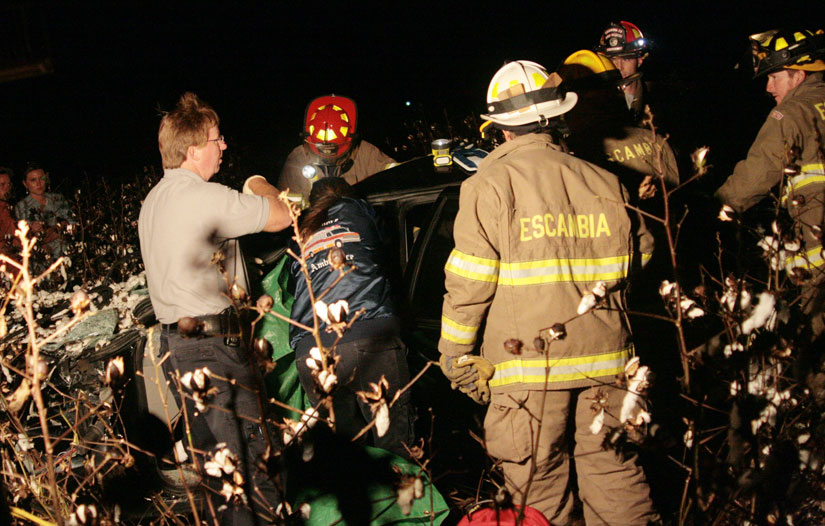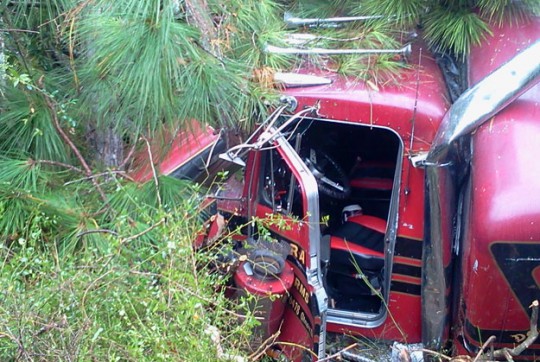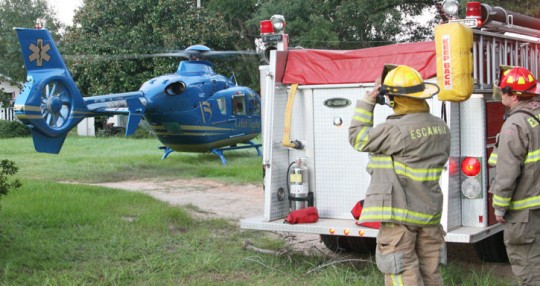Escaped Murderers Captured
October 20, 2013
 The Florida Department of Law Enforcement, along with the U.S. Marshall’s Service arrested escaped inmates Charles Walker and Joseph Jenkins, both 34. The fugitives were found at Coconut Grove Motor Inn, 9725 Front Beach Road, Panama City around 5:40 p.m. Saturday and apprehended without incident.
The Florida Department of Law Enforcement, along with the U.S. Marshall’s Service arrested escaped inmates Charles Walker and Joseph Jenkins, both 34. The fugitives were found at Coconut Grove Motor Inn, 9725 Front Beach Road, Panama City around 5:40 p.m. Saturday and apprehended without incident.
Walker and Jenkins were released separately within the last month from the Franklin Correctional Institution based on forged court documents. The Florida Department of Law Enforcement was notified of the incident on Tuesday.
Walker was serving life without the possibility of parole on a second degree murder conviction from Orange County. He escaped from Franklin Correctional Institution on October 8, 2013, after the Department of Corrections received fraudulent release documents from the Clerk of Court.
Jenkins was serving a life without the possibility of parole on a first degree murder conviction from Orange County. He escaped from Franklin Correctional Institution on September 27, 2013, after the Department of Corrections received fraudulent release documents from the Clerk of Court.
Fall Gardening: Time To Tackle The Chaos And Prepare For Winter
October 20, 2013
Towards the end of the growing season, many landscapes are overgrown and untidy. Allowing plants to tower over others can mean the demise of the smaller plant. It’s time to tackle the chaos and prepare for winter.
 First and foremost, take a good look at your landscape. If a plant has outgrown its allotted space, perhaps it was the wrong plant in the wrong place. Avoid these types of problems by becoming familiar with a plant before you plant it. While you can try to control the size of the plant to fit its space, it will never be a happy, stress-free plant.
First and foremost, take a good look at your landscape. If a plant has outgrown its allotted space, perhaps it was the wrong plant in the wrong place. Avoid these types of problems by becoming familiar with a plant before you plant it. While you can try to control the size of the plant to fit its space, it will never be a happy, stress-free plant.
Information on the mature size of a plant and their site requirements can be found in several Extension publications. The Florida-Friendly Landscaping™ (FFL) “Guide to Plant Selection and Landscape Design” is intended for homeowners who want to take the next step and design their own Florida-Friendly landscapes. Included in this book is information on landscape design strategies, a landscape planning worksheet, and the FFL plant list containing many of the UF/IFAS recommended Florida-Friendly plants for each region of the state. It’s available online by clicking here.
Even in a well-planned landscape, though, the gardener’s controlling influence is important. The most useful methods for dealing with especially enthusiastic plants are removing, pruning, supporting or creating barriers to prevent unwanted spreading.
Removing and replacing
Autumn is an excellent time to establish shrubs and trees. Consider removing oversized plants and replacing them with carefully chosen ones that will happily fit within your defined boundaries. Plants that are installed late in the year will develop strong roots systems before hot weather arrives next spring.
Pruning
 When it comes to pruning, it’s good to remember that it’s better to prune lightly occasionally as needed, than to allow a plant to get way overgrown and then cut it back severely. A few prudent snips here and there will help keep more vigorous plants from overwhelming their less vigorous neighbors.
When it comes to pruning, it’s good to remember that it’s better to prune lightly occasionally as needed, than to allow a plant to get way overgrown and then cut it back severely. A few prudent snips here and there will help keep more vigorous plants from overwhelming their less vigorous neighbors.
Emphasis must be placed on the word “light.” It’s important to remember that late summer pruning may stimulate an additional flush of shoot growth on species which flush several times each year. These shoots could be damaged by an early frost.
Supporting
Another technique to improve the look of an overgrown landscape is staking. Staking or otherwise supporting plants keeps them from leaning or falling over onto others. It helps the tall plant look better, and obviously benefits the plants that would otherwise be covered. The stake should be tall enough to do the job but not be too obvious.
Stakes may simply be placed in such a way that the plant is supported by leaning up against it. On the other hand, it may be necessary to tie the plant to the stake. Typically, twine or plastic ties are used for this purpose. Make sure you tie the lower and upper parts of the plant to the stake to provide proper support.
Other techniques for support include tying twine in a loop all the way around a plant, using a wire cage – this is best done early in the growing season to allow the plant to grow into it – tying a plant to a sturdier, nearby plant or using one of the commercially available support systems.
Barriers
Many perennials and tropical plants spread by underground structures called rhizomes. If growth shows up outside the area you’ve allotted for that plant, promptly dig out the unwanted growth and replant it somewhere else.
Barriers extending at least one foot down into the ground around aggressive spreaders can sometimes help keep them under control. Digging, dividing and replanting clumps of aggressive spreaders annually is another good way to make sure they stay put.
Overgrown shrubs can cause a house to lose its curb appeal. Proper, regular control measures should be employed to keep a landscape looking its best.
Theresa Friday is the Residential Horticulture Extension Agent for Santa Rosa County.
Families Enjoy Free Outdoor Movie
October 20, 2013
Dozens of families turned out Saturday night to enjoy a free outdoor showing of the movie “Despicable Me” on a giant inflatable screen at Walnut Hill’s Bradberry Park. The movie was sponsored by Northwest Escambia Baseball and NorthEscambia.com.
Mattie Lou Cardwell Hosford
October 20, 2013
Mattie Lou Cardwell Hosford, age 89, of Mobile, formerly of Pensacola, went home to be with her Lord Saturday, October 19, 2013. She was born April 14, 1924, in Enterprise, AL, to the late Walter W. Wilson and Elizabeth E. Barnes Wilson.
Mattie was a devoted wife and mother. She was a member of First Baptist Church of Cottage Hill in Cantonment and retired from Monsanto after 26 years of service.
Besides her parents, she was preceded in death by her first husband, Anton Dale “Buddy” Cardwell, Sr.
Survivors include her husband, Merlin Willie Hosford; her sons, Anton D. “Buddy” (Barbara Ann) Cardwell of Hammond, Indiana and Walter D. “Danny” (Judy) Cardwell of Molino; her step-daughter, Debra (Lee) Avinger; her step-son, Willie (Donna) Hosford, all of Mobile; six grandchildren, nine great grandchildren and three great great grandchildren.
Funeral services will be Thursday, October 24, 2013, at 3 p.m. at First Baptist Church of Cottage Hill. Interment will follow in the church cemetery. The family will receive friends at the church from 2 p.m. until the service hour.
Eastern Gate Memorial Funeral Home has charge of the arrangements.
One Injured In Semi Crash
October 20, 2013
The driver of a semi truck was seriously injured in an accident just north of Flomaton Saturday morning.
Just before 11 a.m., the driver lost control and ran off Highway 113 about four miles north of Flomaton. The truck traveled into a wooded area, destroying the semi truck in the process. The driver was trapped in the wreckage for a short period of time as several fire departments worked to free him. He was transported by Escambia County (FL) EMS to D.W. McMillan Hospital in Brewton and then transferred to mobile for further treatment.
The Flomaton, Pineview, Jay and Century fire stations reponded to the crash. Further details have not been released as the accident remains under investigation.
Pictured: A Saturday morning crash near Flomaton. Submitted photos for NorthEscambia.com, click to enlarge.
Florida Gov’t Weekly Roundup: Common Core Clash And More
October 20, 2013
There might not have been a shutdown in Tallahassee this week like the one that finally careened to an end in Washington, but it was still a relatively slow period around state government.
 There were a few bursts of movement. The State Board of Education endorsed Gov. Rick Scott’s efforts to begin backing away from some items tied to the controversial Common Core State Standards, while Education Commissioner Pam Stewart held public hearings on the standards themselves.
There were a few bursts of movement. The State Board of Education endorsed Gov. Rick Scott’s efforts to begin backing away from some items tied to the controversial Common Core State Standards, while Education Commissioner Pam Stewart held public hearings on the standards themselves.
Meanwhile, the Public Service Commission came to “the best resolution at this time” with Duke Energy Florida — a plan that drew a rebuke from the newest soon-to-be member of the Legislature.
A BUSH-SCOTT RIFT ON SCHOOLS?
For those following the ongoing, wonkish soap opera involving rumors of a rift on education between Scott and former Gov. Jeb Bush, the week provided a few hints into how much truth might be behind those whisperings — but no real confirmation of any kind.
First came news that Sally Bradshaw, who served as chief of staff under Bush, was leaving the board months before the Dec. 31 end of her term. In a letter, Bradshaw wrote that she was resigning because of “family obligations” — something that did very little to tamp down speculation that something else was at play.
If there was, Scott certainly didn’t let on.
“We are grateful for Sally’s service and commitment to ensuring the highest quality in our education system,” Scott said. “She has worked hard to continue the legacy of high standards that began under the great leadership of Governor Jeb Bush.”
But another former Bush chief of staff, board member Kathleen Shanahan, was among those wondering whether the state was watering down its commitment to Bush’s education reform agenda. Shanahan, who has grown increasingly critical of Scott since it became clear she would not be reappointed to the board, was one of two dissenting votes on a proposal to extend a policy to prevent schools from dropping by more than a letter grade on their state-issued report cards.
The “safety net,” first used on report cards issued after the 2011-12 school year and continued during the current year, will now cover schools through the 2014-15 year.
Supporters said the extension will buffer schools through the transition to a new testing regime under the “Common Core State Standards.” The new tests are expected to kick in during the 2014-15 year.
“I do think that it is more important on that final year [of the transition],” said Board Chairman Gary Chartrand.
Shanahan wasn’t convinced.
“A four-year safety net becomes a bureaucracy, in my opinion,” she said.
And Patricia Levesque, executive director of Bush’s Foundation for Florida’s Future, knocked the school-grading move in a statement issued later Tuesday.
“Florida is in a period of transition to higher standards, and stability and transparency during these times is key,” she said. “That transparency provides valuable information on the state of student learning — what matters most — even when it’s not what we want to hear.”
COMMON CONTROVERSY
The board also took aim at some of the implementation of Common Core, voting not to adopt a series of “appendices” to Common Core, including items like reading lists or suggested tasks for students. Shanahan also questioned that move, saying the appendices could help teachers. “I don’t know why we’re disarming the teachers,” she said.
Bush has been a strong supporter of Common Core, while Scott has taken steps to distance Florida from a multistate test related to the standards, which almost four dozen states have adopted. Scott also ordered Stewart to hold a series of hearings on the subject.
Those hearings featured speakers on both sides of the issue — some who called for the end of Common Core, which opponents see as federal intrusion into local schools, and those who promoted the new benchmarks as the way forward for education.
“Common Core is providing a more rigorous and engaging classroom environment. … Common Core is pushing the students to think beyond a textbook,” said Melissa Castro, an 18-year educator with Hillsborough County, during a hearing in Tampa.
But opponents assailed Common Core as potentially wasteful and harmful. Some labeled the changes “education without representation.” They said the new standards were almost incoherent and difficult for some students.
Lori Baxley, who has two children, spoke emotionally about how her son, a fourth-grader who previously made straight As, was struggling with his math homework. That made her speak up, Baxley said, not any political considerations.
“The notion this issue is political baffles and frustrates me,” she said during the hearing.
Just before the last of the hearings, held Thursday in Tallahassee, Stewart said it’s too early to tell what she might recommend to the State Board of Education regarding Florida’s education standards.
But she refused to rule out the possibility that Florida would abandon Common Core.
Speaking to reporters before the third public meeting to gather public comments on the standards, Stewart brushed off the idea that the state was “reversing course” on Common Core. But pressed on whether getting rid of Common Core was on the table, Stewart didn’t directly answer.
“Well, certainly, that’s input,” she said. “So, as I said before, we’re going to take all of the input and we’re going to make a determination of exactly where we want to head as a state as far as moving forward on rigorous standards for our students.”
DUKE’S NUKES
One thing that won’t be abandoned, at least not yet, is the charges that customers will pay for a scrapped nuclear power plant and another that’s been shuttered as part of a deal between the Public Service Commission and Duke Energy Florida.
For customers, the deal will include an increase in the residential bill of $8.24, about 7 percent, on a 1,000-kilowatt hour bill starting in January.
Under the agreement, approved 4-1 on Thursday, Duke customers will see a freeze on base electric rates maintained through 2018. But they will also fork over an amount translated to $3.45 a month for a residential customer who uses 1,000 kilowatt hours of electricity through 2017 to help pay for a scotched plan to build two nuclear reactors in Levy County.
The company spent $1.5 billion on the project, so the charges will go to cover previously approved costs and equipment already purchased.
Another part of the deal involves Duke’s decision to permanently shut down a Crystal River nuclear plant that has been offline since 2009.
The agreement caps the amount Duke can recover at $1.4 billion, of which $295 million will be shifted to stockholders.
The deal marked “the best resolution at this time,” PSC Chairman Ronald Brisé said.
“There is now a fence around the things we can control,” said Brisé. “It provides a certain level of certainty for a particular amount of time and it also takes off the table Levy (County nuclear plant) and it addresses many other challenges that could come about and would have to go through various processes in order to get some resolution.”
But the deal was already coming in for criticism from Pasco County Democrat Amanda Murphy, who on Tuesday won a House seat in a special election to succeed former GOP Rep. Mike Fasano, also a frequent foil of the utilities.
“It is outrageous that the Public Service Commission would agree that ratepayers should be held responsible for another $3.2 billion in fees for a power plant that will never be built,” Murphy said in a release on Friday, referencing the full cost of the Duke settlement. “There is no question that the Florida Legislature must act now and repeal the irresponsible nuclear cost fee.”
It was one of the first things Murphy did after defeating Republican Bill Gunter in the Tuesday election. She carried 50.8 percent of the vote to Gunter’s 49.2 percent.
The win by Murphy, 43, gives Democrats 45 seats in the 120-member House. That is still far short of the 75 seats held by Republicans, but it represents a pickup for the caucus that has long been the minority in the chamber and recently saw a contentious leadership battle. And it gave the party hope as it heads into the midterm elections.
“I think that election in Pasco County was really like a litmus test in terms of where Florida is,” said Rep. Mark Pafford of West Palm Beach, who is slated to take over as House Democratic leader after the 2014 elections.
STORY OF THE WEEK: Democrat Amanda Murphy defeated Republican Bill Gunter in a special election for a House seat in Pasco County.
QUOTE OF THE WEEK: “Let’s give teachers a real raise, not Governor Scott’s mysterious vanishing raise.”–Mike Weston, a parent, teacher and candidate for the school board in Hillsborough County, on what should be done with the money that would go to implementing Common Core. Scott’s much-touted pay raise for educators, approved by the Legislature this spring, has been bogged down in negotiations between local school districts and teachers’ unions.
By Brandon Larrabee, The News Service of Florida
Tate, West Florida Join Architectural Firms For CANstruction For Manna
October 20, 2013
Two local high schools joined seven architectural firms for CANstruction 2013 Friday night at the Artel Gallery in downtown Pensacola.
Tate and West Florida high schools presented their designs — constructed of cans of food — alongside creations by members of the American Institute of Architects (AIA) of Northwest Florida. The thousands of cans of food were all donated to Manna Food Pantries.
Pictured top: “No Hunger” by Tate High School. Pictured inset: “Mega-can-o-saurus” by the West Florida High School Engineering Academy. Pictured below: “Kill Hunger” by Bay Design Associates and Sam Marshall Architects, the firm designing the new Ernest Ward Middle School in Walnut Hill. There are 1,511 cans for the hungry in the design. Pictured bottom: “PAC-CAN” by Bullock Tice Associates with 1,304 cans for Manna. Courtesy photos for NorthEscambia.com, click to enlarge.
Fred Warren Johnson
October 20, 2013
Mr. Fred Warren Johnson, 75, passed away on Thursday, October 17, 2013, in Atmore.
Mr. Johnson was a native of McCullough, AL, and had resided in Atmore since 1985. He was farmer for many years and a welder at the Alabama Tank Company. He was a loving husband, father and grandfather. He attended the West End Baptist Church.
Mr. Johnson is survived by his wife, Roberta Johnson of Atmore; one son, Darin (Kathy) Johnson of McCalla, AL; three daughters, Sandy Johnson (Jack Hadley) of Uriah, AL, Robin (Jeff) Fernandez of Freeport, and Vickie Bowen of Uriah, AL; one brother, James Ray “Buddy” Johnson of Waynesboro, MS; one sister, Olga Barton of Fairhope; 12 grandchildren and one great-grandchild.
.
Funeral services will be held at the Petty-Eastside Chapel Funeral Home on Sunday, October 20, 2013, at 3 p.m. with the Rev. Carl Ropke and Rev. Alan Chace officiating.
Burial will follow at the McCullough Cemetery.
Visitation will be Sunday, October 20, 2013, from 1 p.m. until service time at 3 p.m. at the Petty-Eastside Chapel Funeral Home.
Pallbearers will be Evan Johnson, Colton Bowen, Richard Chasez, Roy Chasez, Joe Barber, Greg Norwood, Robbie Fergurson and Nate Fernandez.
Petty- Eastside Chapel Funeral Homes is in charge of all arrangements.
Rain Should End In Time For Free Family Movie ‘Despicable Me’ Tonight At The Ballpark
October 19, 2013
The Northwest Escambia Baseball Park and NorthEscambia.com are teaming up to bring you a free Family Movie Night. Tonight at 7:00, we’ll bring you “Despicable Me” on the big screen. The rain should be ending before movie time.
Attendees are encouraged to bring chairs since the ground is wet. Hot chocolate and coffee will be available if it gets cook, along with other concessions.
No outside coolers. This is a family event; no alcohol or inappropriate behavior will be tolerated.
Admission is free, but donations will be accepted toward the cost of the event for NWE’s 2014 baseball season.
Bradberry Park is located on Highway 99A in Walnut Hill, directly behind Ernest Ward Middle School.
Study: Country Life Riskier Than City Living
October 19, 2013
Contrary to what many believe, living in the city is far less risky than in the country, according to a study released on Tuesday that takes into account all major forms of death from injuries.
Although homicides in cities far outpace those in rural areas, overall the risk of dying from some form of accident or injury is 20 percent greater in the most rural counties of the United States than in the nation’s biggest cities.
The findings may give pause to people tempted to flee cities for the bucolic ideal of rural life, says Dr. Sage Myers, a pediatric emergency medicine specialist at the University of Pennsylvania and the Children’s Hospital of Philadelphia, whose study was published in the Annals of Emergency Medicine.
 “As you move further and further away from cities you got less and less safe. Even going into the suburbs dropped your safety a little bit,” she said.
“As you move further and further away from cities you got less and less safe. Even going into the suburbs dropped your safety a little bit,” she said.
“It’s a little counter-intuitive,” she said.
Myers said when people think of their personal safety, they tend to think about intentionally inflicted injuries, such as being attacked or shot, but the researchers found that the risk of dying from an accidental injury is 40 percent higher in the nation’s most rural counties than in its most urban.
“It turns out unintentional injuries dwarf intentional injuries,” Myers said, and those types of injuries occur much more often in rural areas.
Part of the differences in the study may reflect reduced access to trauma centers, which are staffed with doctors who are trained to handle life-threatening injuries. And since most trauma centers are clustered near large cities, rural dwellers may be more at risk of dying from life-threatening injuries.
Car crashes, homicides
Myers and colleagues studied government data on all injury-related deaths from all 3,141 counties across the United States from 1999 to 2006. They excluded deaths caused by the 9-11 attacks, which the researchers deemed too anomalous to be counted.
Of the nearly 1.3 million deaths during the study period, the overall rate of deaths caused by accidents was 37.5 per 100,000, compared with 17 per 100,000 for homicide and suicides.
 The most common causes of injury-related deaths were motor vehicle crashes, which occurred at more than twice the rate in rural areas as they did in cities. Overall, car crashes caused 27.61 deaths per 100,000 people in most rural areas and 10.58 per 100,000 in most urban areas.
The most common causes of injury-related deaths were motor vehicle crashes, which occurred at more than twice the rate in rural areas as they did in cities. Overall, car crashes caused 27.61 deaths per 100,000 people in most rural areas and 10.58 per 100,000 in most urban areas.
That may be because people in rural areas are more prone to drive on highways at high speeds, and some studies have shown people in rural areas are less likely to comply with seatbelt and child restraint laws than are individuals in urban areas.
When the team looked at firearm-related deaths, they found no significant difference in the overall risk of death between urban counties and rural counties, but there were significant differences in the trends by age.
In rural areas, for example, children aged up to 14 and adults over 45 had the highest risk of dying from a firearm injury, but among adults aged 20 to 44, the risk of a firearm-related death was much higher in urban areas, and the risk was about the same for youths aged 15 to 19, regardless of where they lived.
The study did not look at the number of people who were injured but survived their car crashes or gunshot wounds, which might reflect whether people in urban areas simply have better access to healthcare than people in rural areas who have life-threatening injuries.
Myers said more study is needed to tease out the differences in risks between urban and rural areas, but she said such studies should be taken into account as health policy experts consider the placement of new trauma centers.
Pictured top: LifeFlight lands in the yard of a home near Walnut Hill for a rattlesnake bite victim. Pictured top inset: A driver was trapped in their vehicle in cotton field after colliding with an 1,800 pound bull in Walnut Hill. Pictured bottom inset: A shooting outside a Pensacola shopping center. Pictured below: A man is airlifted by LifeFlight following a grocery store shooting. NorthEscambia.com file photos, click to enlarge.
[VOA]














